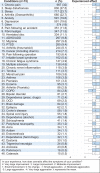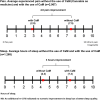Beyond the high: Mapping patterns of use and motives for use of cannabis as medicine
- PMID: 35310614
- PMCID: PMC8899253
- DOI: 10.1177/1455072520985967
Beyond the high: Mapping patterns of use and motives for use of cannabis as medicine
Abstract
Background: In Denmark the boundaries between cannabis as an illicit drug and licit medicine have shifted rapidly in recent years, affecting also policy. However, the vast majority of Danes, who use cannabis as medicine (CaM) continue to rely on the unregulated market for supply. This study explores patterns of use and motives for use of CaM in Denmark.
Methods: An anonymous online survey was made available to a convenience sample of users of CaM from July 14, 2018 to November 1, 2018. Participants were recruited through patient organisations, social and public media, and the illegal open cannabis market.
Results: Of the final sample (n = 3,021), a majority were women (62.6%) and the mean age was 49 years. Most had no prescription for CaM (90.9%), a majority had no or limited previous experience with recreational cannabis use (63.9%), and had used CaM for two years or less (65.0%). The most common form of intake was oil (56.8%) followed by smoke (24.0%). CBD oil (65.0%) was used more than hash, pot or skunk (36.2%). Most frequent conditions treated were chronic pain (32.0%), sleep disturbances (27.5%), stress (23.7%), osteoarthritis (22.7%), anxiety (19.6%), and depression (19.6%). Overall, users experienced CaM to be effective in managing somatic and mental health conditions and reported relatively few side-effects. CBD oil only users were more likely to be women, older, have limited recreational experience and have initiated use recently.
Conclusions: A new user group has emerged in Denmark that, for the most part, use illegally sourced CaM to treat a broad range of somatic and mental health conditions, often with experienced effect and relatively low level of side-effects. The prevalent use of low-potency CBD oil indicates an interest in effects beyond the high normally associated with cannabis use. More clinical research into the effects and side-effects of CaM is needed to draw the boundaries of the medical utility of cannabis.
Keywords: CBD; cannabis; medical cannabis; medicinal cannabis; motives for use; user patterns.
© The Author(s) 2021.
Conflict of interest statement
Declaration of conflicting interests: The authors declared no potential conflicts of interest with respect to the research, authorship, and/or publication of this article.
Figures
References
-
- Althubaiti A. (2016). Information bias in health research: Definition, pitfalls, and adjustment methods. Journal of Multidisciplinary Healthcare, 9, 211. http://doi:10.2147/JMDH.S104807 - DOI - PMC - PubMed
-
- Alvaro P. K., Roberts R. M., Harris J. K. (2013). A systematic review assessing bidirectionality between sleep disturbances, anxiety, and depression. Sleep, 36(7), 1059–1068. http://10.5665/sleep.2810 - DOI - PMC - PubMed
-
- Barratt M. J., Ferris J. A., Lenton S. (2015). Hidden populations, online purposive sampling, and external validity: Taking off the blindfold. Field Methods, 27(1), 3–21. 10.1177/1525822X14526838 - DOI
LinkOut - more resources
Full Text Sources



